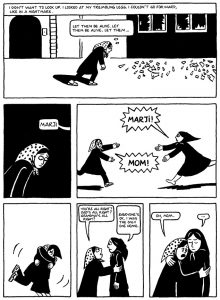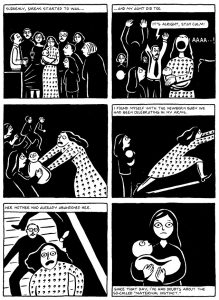Fear, the emotion that every people has been experiencing, is most primitive emotion that human has developed through several evolutions. Fear changes people. Fear makes people weak. Fear makes people emotional. Fear makes people agitational. People feel fear from different subjects. Numerous and various things trigger fear to people and every individual expresses their fear differently.
In ASTU 100 class, our class has been reading the comic book, Persepolis – The Story of a Childhood which contains author’s personal experience of her childhood during Iranian Revolution. Marji – the representation of author in the story – witnessing public issues, political regime, war, acts of violence from her childhood memory through her comic book. As the story situated in the revolution and war, the fear is the emotion that Marji and characters always carry with their everyday life.
Throughout the book, different aspects of fear can be observed: fear of death, fear of losing people, fear of losing a country. In the story, those fears exist around characters like the oxygen, and it seems unnatural to not observing the fear in the story. It was quite interesting to observe how different characters express fear differently and how they change.
Considering fear as one of the instinct that human has, feeling fear makes human to reveal their innate characteristics and makes human to protect one’s most precious things: whether is the object, family, or oneself. When a fire breaks out in the house, a fire makes people feel the fear of death. Therefore, people usually ran to protect something that they consider as most precious in the world. For people who ran out from the house: one’s life. For the mother who ran to her children: her children. For the husband who ran to her wife: his lover. For mistress who ran to her room: her jewels.
I could find how fear changes human by reading Persepolis. As it was based on author’s – Marjane Satrapi – the personal memoir of Iranian Revolution, the descriptions and illustrations came as the fact and truth from Marji’s perspective. When the bomb had hit Marji’s street during the war, the illustrations expressed the fear of losing family.

The fear of losing mother – for Marji – and daughter – for Marji’s mother – clearly illustrated in the frame. The black background of the frame – before Marji met her mother – showed the fear and frustration of Marji’s concern of losing her mother. The barefoot of Marji’s mother showed how desperately she escaped from bombing and looking for her daughter, Marji.
Contrasting to Marji and her mother’s situation, there was also the situation where the fear makes people reveal one’s innate characteristics. When the sirens started to wail during the celebration party of the newborn baby, Marji’s aunt was seized by the fear of death that overpowered “maternal instinct” and abandoned her own baby.

The illustrations expressed how fear manifest human’s innate characteristics. I couldn’t judge whether the character’s – Marji’s aunt – an action was selfish or not, it clearly showed her aunt was caring more about herself than her own baby and how influential the fear is to human that make someone abandon “maternal instinct.”
The fear is primary instinct of human to survive. It is existing everywhere and every second around people. Fear not just alert the critical danger to survive but it also disclose your innate personality whether is good or bad. Whether how influential and powerful the fear is, it’s one’s responsibility to evoke this fear or moreover overcome.
Sources:
Satrapi, Marjane. Persepolis. Vol. 1, Pantheon, 2004.